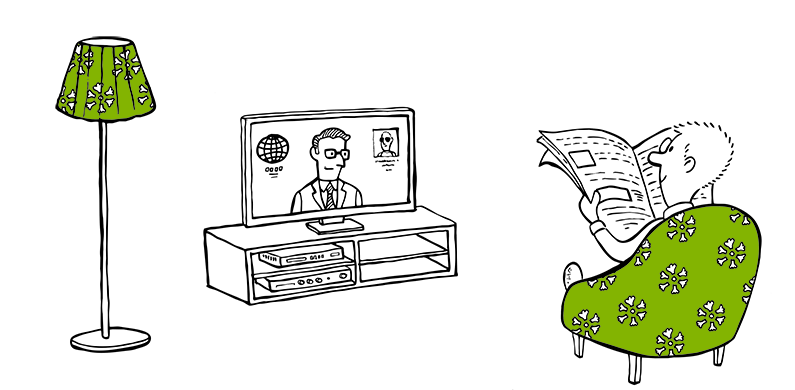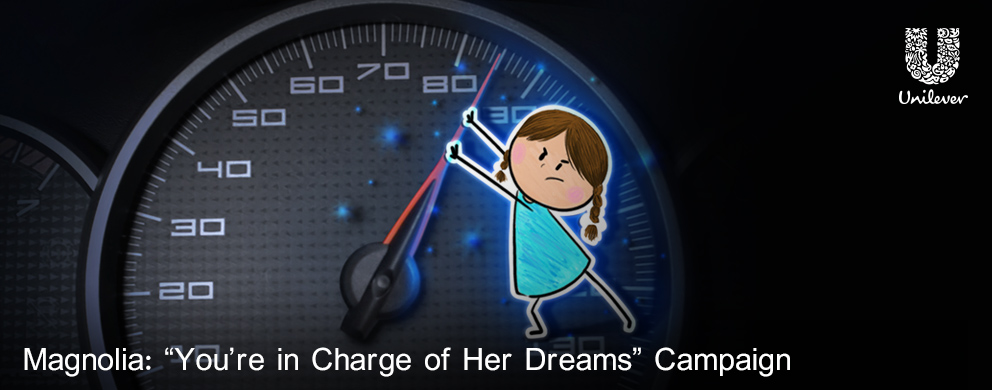
Magnolia: “You’re in Charge of Her Dreams” Campaign
The daydreaming of the girl in the story is very effective: A girl who talks to the audience with her illustrated dreams about of her father death and about her imaginations. This video has been designed for the Unilever internal campaign. In addition to this video, posters have also been designed in which the audiences have been alarmed against the unauthorized speed, non-use of mobile phones, and fastening the seat belt while driving.
It is a campaign for which the motto “You’re in charge of her dreams” has been chosen, outlined and implemented by the Magnolia Advertising Agency.
In order to get more information about this campaign we held a roundtable discussion with the presence of Unilever Shopper Marketing Assistant Manager, Nasrin Farahnak, and the creativity and implementation team, Pooya Sabbagh, the Project Manager; Milad Mohsenifar, Idea Generator; Arash Pirsalehi, Arts Director; Silva Shah Nazarian, the Executive Director from the Magnolia Advertising Agency.
What is Unilever’s goal of running an internal campaign?
Nassrin Farahnak: Given that the objectives and values of Unilever become meaningful with the presence of the people, and we have formed a large family together, we have held different campaigns to protect the safety of the people under different titles in order to:
• Raise staff awareness
• Emphasize the importance of the health of individuals and their families for the Unilever
• Involve individuals and their families in the campaign in order to avoid any irreparable incident.
Why have you designed the campaign for safe driving?
Farahnak: With regard to the shocking statistics about car accidents in Iran, and considering that unfortunately, the largest number of accidents occurs during the Nowruz holiday, therefore with the approach of the new year, we decided to once again remind the people that by observing a few points we can easily prevent unfortunate events to a possible degree: Incidents that can be costly for us and our families.
Who are the audience of this campaign?
Farahnak: All those who works directly and indirectly for Unilever and their families.
What parts is the campaign composed of and what tools have you used to transmit the message?
Farahnak: In this campaign, three main messages have been used (seat belt, mobile phones and speed) at various intervals through video and different texts, as well as activities to further involve people and families in this campaign, through advertising tools, email, SMS, Instagram, letter, leaflet and the new year calendar in order to convey the message and communicate with the audience.
The video is not alarming and it affects the emotions of the audiences, why contrary to other cultural videos such an approach has been chosen?
Farahnak: Alarming videos are being broadcast in different media and this time we decided to examine the incident from another perspective so that by influencing their emotions further influence the audience and ask them to drive more safely in order to provide security and safety for their beloved ones and reach their destination safe.
How has been the feedback of this campaign, and will the campaign be continued?
Farahnak: It has been excellent and impressive. Regarding the fact that, unfortunately, the highest rate of accidents in Iran occurs at Nowruz (New Year) holidays, we hope to see the positive effects of this campaign during those days.
Yes. In the next year it will continue in different periods. At the end, I should thank my colleagues including Marjan Valvi the Brand Manager, Nosrat Divigi the Sales Manager, and Samira Sohrabifar, Assistant to Shopper Marketing, for their collaboration and implementation of this campaign.
In this roundtable panel, the design and implementation team will answer the questions related to this section.
Tell us about the strategy of Unilever’s internal campaign?
Sabbagh: In this campaign the Unilever Sales Unit intended to send a message to the company’s internal staff: An emotional message that the audience after receiving it revised their driving style or drive more carefully. The company tried to put the audience in line with its goal by sending an emotional message and thus increase the effectiveness of the message. However, the driving style of the people influences their lives and their society and paying attention to this important point, especially by the sales team at Unilever, is highly significant. We needed to design the content of the campaign in such a way that individuals, in addition to paying attention to it, be also persuaded to practice it with their families.
This campaign had an important point: we were not expected to introduce a product or a service to the audience according to which we could examine the market or issues as such. The type of the campaign was different from the rest of the activities which have been performed. In order to collect information we had to go after other statistics: Statistics showing the number of accidents and the mortality rate. Such statistics helped us to better assess the impact of bad driving. The statistics were shocking. The number of accidents in Iran was several times more than those in other countries. The statistics said every two minutes there was an accident and every 19 minutes a family would be informed of the accident of its beloved one.
Those who are involved in an accident are only one side of the case, the family and those who have to bear the psychological burden of the accident of their loved ones are the other side. Such people also tolerate a heavy burden in terms of mental health.
After studying the case, we concluded that no matter how directly we send the message to the drivers, we would not get the result. Because direct messages have been repeatedly sent to the drivers and they have been alarmed: Campaigns that, according to statistics, have not had much impact. We had to design the message in such a way that it covered the family and the community around the drivers. By influencing the family and the community, we could also influence the drivers and inform them.
Accidents will cause the survivors to enter into a major crisis. The adult survivors could probably control themselves and accept the reality. But children have no image of death and would severely damage out of the accident of their relatives. After accidents, the children are caught up in gatherings where people are disturbed and confused. The children are unaware of the causes of family anxiety, but the morale of others would affect them and the effect of the event will remain with them eternally. As a result, in order to design the message, it was decided to show the impact of this effect on the children to the audience. With such an approach, we entered into the idea generation and creativity stages of the campaign. The stage that we should pay attention to the three factors of “unauthorized speed, non-use of mobile phone and fastening the seat belt” while driving.
Please explain the stage of idea generation in the campaign?
Mohsenifar: After receiving information from the strategy team, we noticed that the message of the campaign, in addition to being emotional, was reminder of a painful incident for the audience as well: The audience who were not directly targeted but were expected to focus on their families and relatives and influence them. During the idea generation and developing the scenario, we carefully studied the children in our surrounding: The children with whom we talked about the issue of death. Children’s ignorance of the death was very shocking. Therefore, who could be better than an unaware child to narrate the campaign? We put ourselves in the child’s place and looked at the subject from the angle of her view. So the narrator of the story was a girl who, in her language and tone of her dialect, told the story to the audience.
In designing the motto of the campaign, we also tried to notify the parents who are driving. The parents to whom we said: their bad style of driving is something related to them. But they should take this point into consideration that their style of driving would affect their children in future and would ruin their dreams, and in fact parents are responsible for the realization of their children’s dreams.
During our conversation with the children, we realized that they would use allegories for death such as when a person dies he would fly to the heavens or he will remain with God. We illustrated such imaginations in order to convey the message: Illustration in which a child wishes to grow up and become rich: A child who is looking for his father in the heavens. For this campaign, a video and three plans have been prepared. The message of the three designs has been passed directly to the audience. Of course in three designs, we just use video imaging. Such a practice has created a connection between the video and the three designs.
Sabbagh: The main platform of the campaign was “You’re in charge of her dreams”, around which the entire content of the campaign is revolving. Therefore, the main umbrella of the platform remained and on its basis, in three plans factors of the seat belt, mobile phone and unauthorized speed were considered and in the video the emotional message was conveyed to the audience.
Please explain the process of designing the campaign?
Pirsalehi: Based on the campaign strategy, we began to illustrate the most effective state a child could be when his or her parents die. Such an approach was exactly in parallel with the motto “You’re in charge of her dreams”. In this video, we took the father responsible for his child’s dreams. In this video we tried to make all the factors actual: Factors that increase the effectiveness of the message altogether. The girl in the story draws exactly the picture derived from her childhood thinking: A painting in which the shape of the sun, the mountain and so on is derived from the abstract thinking of the child: A child for whom death is obscure and portrays such unclarity in a childish painting: A painting that fantasizes and is fully understandable for the family and the relatives. When painting, the child thinks exactly that everything is real and she has been able to illustrate her thinking in the best possible way. The child illustrates the message of the campaign in the painting. A child who has lost her father and has been told that the father had gone to the heavens, she would go to the sky in search of the father. A child who wants to have a telescope and dreams of growing up in order to buy one in order to see her father in the heavens. A telescope which had been promised to her by the father before his death but the accident prevented realization of the promise.
In this video we used a technique in which the child enters from the real world into the fantasy and the painting world. A technique by employing which the effectiveness of the message was doubled and resulted in the attraction of the audience. In the video, we used simple lines to pinpoint the drawing of a child. Regarding the feedback we received, it seems that we achieved the success we were expecting.
As for the image of the posters, I should say the cartoon face of the child was so attractive that it could best convey the message to the audience: A girl who in the posters stands against unauthorized speed, not fastening the seat belt, and using the mobile phone while driving. Poster designs, in addition to simplicity, were also funny.
Tell us about the executive steps of the campaign?
Shah Nazariyan: This campaign began with the teasing phase. At the beginning of the campaign, the teasing message was sent to the audience via email. In Unilever’s message, it was said that Unilever consider all the employees as its own and the Unilever staff are part of the big family with which Unilever finds meaning: Employees and families whose health is very important for Unilever. This email was sent to the employees with a shocking title “You’re in charge of her dreams”. Curiosity of the audience was completely provoked after receiving this email was noteworthy. The audience we expected to follow the rest of the campaign after receiving the email. In the second stage, the video was displayed to the audience via email, SMS and LCDs installed in the company office. This video was displayed for the audience both with the Persian and English subtitles. After the video was screened, we received influential reactions from the audience: The audience who had cried or remained steady and motionless in front of the LCD after watching the video.
To further enhance the influence of the video, the content of the campaign was installed throughout the company by various print items. Dangler, poster, roll up and so on were the items used in the campaign. The items recall the message of the campaign to the audience. A message in which it is emphasized to the audience that unauthorized speed is prohibited, fastening the seat belt is mandatory and mobile phones should not be used while driving.
After this stage, a motion graphics in which the shocking statistics of accidents had been shown was sent to the audience. In the motion graphics, the audiences were asked: Are you aware of the statistics of accidents, do you know that every 19 minutes families lose one of their beloved ones? … At the end, they were told as they are important for Unilever, therefore they should observe the three points of the seat belt, mobile phones and speed.
In the concluding stage, the staff was told to ask their children or their relatives to paint their dreams and send it to Unilever. The paintings have been collected and are due to be installed after the New Year holiday on a signboard at Unilever’s main office. The paintings that employees, every time passing by, would remember what are the dreams of the children and therefore they should care for their dreams. No limit had been considered for the paintings of the children and they could use any means for their painting.
What are the differences between internal and public campaigns?
Sabbagh: In the Unilever internal campaign, we were faced with nearly 2,000 internal audiences and their families. This number of audience is a good sample of the society. The audiences from different sections of the organization and accordingly their type of behavior and culture differed from each other. We had to design for them an emotional, simple, and understandable message. Therefore, the internal campaign is a small version of the public campaign. Of course, we also encountered a media constraint for the internal campaign. We had to design the content for a number of media outlets through email and SMS, and the organization’s interior atmosphere. Because, if you put the video in a media like Instagram, it would become viral fast. In this campaign, only with the repetition and sound use of the media, we could send the message to the audience and increase its effect.
Shah Nazarian: I think that the restrictions on using the media made the idea generation of the campaign extraordinary. Because, when the platform is wide, the idea may work in any way. But, in a small platform, idea generation should be so strong that it could be conveyed to the audience through an email or SMS in the best possible way. This campaign will continue until the end of the month of Ordibehesht (April/May).
Pirsalehi: The restrictions made it possible to convey a right message through a right channel to the audience. Such a performance has led to the achievement of the result of the campaign.








